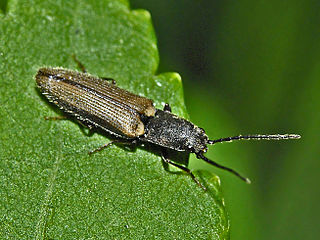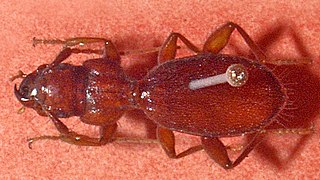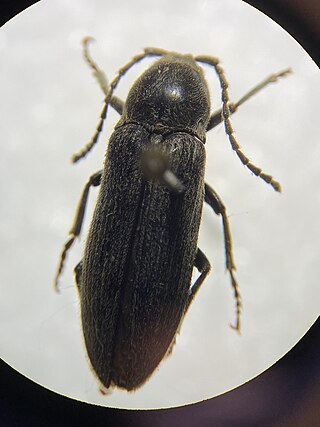
Metallyticus splendidus is a rare species of praying mantis found in Southeast Asia. It has an iridescent appearance.

Leptostylopsis annulipes is a species of longhorn beetles of the subfamily Lamiinae.

Cebrionini is a tribe of click beetles from the family Elateridae; formerly ranked as a subfamily or family, they are now considered a tribe within the subfamily Elaterinae.
Abacetus pumilus is a species of ground beetle in the subfamily Pterostichinae. It was described by Boheman in 1848. Abacetus pumilus is a small, but distinctive, beetle with red legs and antennae, and a green tinge on its wings. Very little is known about Abacetus pumilus habitat, however it is found throughout the arid deserts and semi-arid steppes of southern Africa.

Zigrasimecia is an extinct genus of ants which existed in the Cretaceous period approximately 98 million years ago. The first specimens were collected from Burmese amber in Kachin State, 100 kilometres (62 mi) west of Myitkyina town in Myanmar. In 2013, palaeoentomologists Phillip Barden and David Grimaldi published a paper describing and naming Zigrasimecia tonsora. They described a dealate female with unusual features, notably the highly specialized mandibles. Other features include large ocelli, short scapes, 12 antennomeres, small eyes, and a clypeal margin that has a row of peg-like denticles. The genus Zigrasimecia was originally incertae sedis within Formicidae until a second species, Zigrasimecia ferox, was described in 2014, leading to its placement in the subfamily Sphecomyrminae. Later, it was considered to belong to the distinct subfamily Zigrasimeciinae.
Paraulax queulensis is a species of gall wasp. Biology of Paraulax species is unknown but given they are associated with Nothofagus forests their biology is probably associated with the pteromalid gall community. This species is named after the place where it was first collected, Los Queules National Reserve. P. queulensis closely resembles P. perplexa, bearing common traits such as colour, habitus and several morphological characters. P. queulensis differs by having a more elongate body, which in the female is 4 times longer than it is high; its mesosoma is 1.6 times longer than high, while its metasoma is 1.9 times longer than high. The mesosoma is more dorsoventrally depressed. Its pronotum s 1.5 times longer laterally than high. It possesses longitudinal costulae running from the lateral margin of its pronotal plate to its lateral surface. Its scutellar foveae is discernible even when shallow. The antenna also differs: the pedicel of the female antenna is 1.4 times longer than wide.
Paraulax ronquisti is a species of gall wasp. Biology of the Paraulax species is unknown but given they are associated with Nothofagus forests their biology is probably associated with the pteromalid gall community. It is named in honour of Fredrik Ronquist. This species differs from P. perplexa and P. queulensis by its body's red-brown color, the shape of the antennal flagellomeres F3 and F4, the faint notauli and its smooth and shiny mesopleuron. It has an elongated body like P. queulensis.

Athous bicolor is a species of click beetle.

Siagona jenissoni is a species of beetles in the family Carabidae.
Melasis fermini is a rare species of soldier beetles native to a small area of Spain. It has only been found in three locations in Guadalajara, Caceres, and Ciudad Real, and its estimated range is less than twelve square kilometers. The species was named in honor of the late Fermín Martín Piera, a Spanish biologist and taxonomist who specialized in the study of dung beetles.
Yuanjiawaornis is an extinct genus of large enantiornithean bird known from the early Cretaceous of present-day China. It is monotypic, with only type species Y. virisosus known.
Psammoecus delicatus, is a species of silvan flat bark beetle found in India, Sri Lanka, Taiwan, Singapore, and Indonesia.
Silvanus difficilis, is a species of silvan flat bark beetle widespread in Oriental region. It is introduced to Australia via timber and also to Costa Rica.
Silvanus imitatus, is a species of silvan flat bark beetle found in India and Sri Lanka.
Silvanus lewisi, sometimes known as Asian silvanid beetle, is a species of silvan flat bark beetle found throughout the Oriental region and introduced to many parts of the world.
Onthophagus gemma, is a species of dung beetle found in India, and Sri Lanka.
Onthophagus negligens, is a species of dung beetle found in India, and Sri Lanka.

Proagoderus pactolus, is a species of dung beetle found in India and Sri Lanka.
Holostrophus toyoshimai is a species of polypore fungus beetle in the family Tetratomidae. Being identified in 2017 by Masahiro Saitȏ and Ondřej Konvička, Holostrophus toyoshimai was identified upon the discovery of five specimens located within central Honshu to which they were identified as a new species.

Perothops is a genus of false click beetles in the family Eucnemidae containing 3 species. They are known as beech-tree beetles or perothopid beetles. They are small as they are only 10–18 millimeters long. It is the only genus in the monotypic subfamily Perothopinae. They are dark-colored beetles that are found across the United States, generally in forests. The genus was discovered by Johann Friedrich von Eschscholtz in 1836. It used to be considered a family not part of Eucnemidae. The genus's name is from Greek, translating to "maimed/crippled eye" or "eye of little necklaces/bands", referring to the placement of perothopid eyes.







